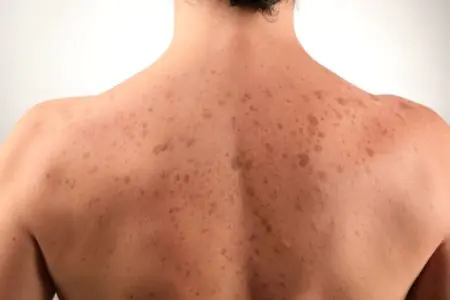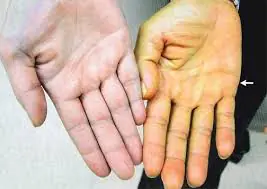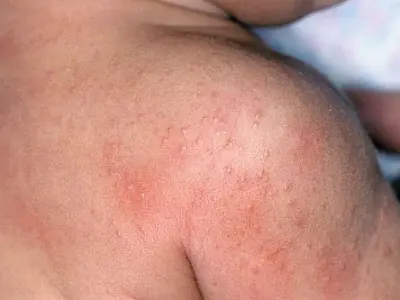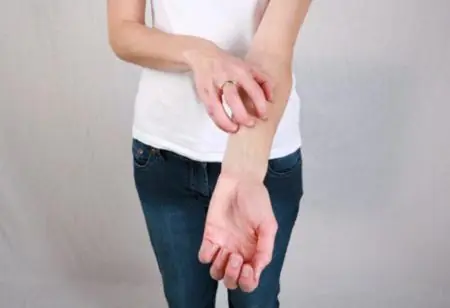The term “liver spots” often refers to several types of skin manifestations: from skin lesions that are symptoms of liver disease to completely harmless pigmentation disorders associated with age.

Age-related skin changes (pigmentation disorders)
These rashes go by several names: age spots or age spots, solar or senile lentigo, and, of course, liver spots. This name is not associated with the functions of the liver, but with the brown color of the rash, reminiscent of the color of the liver.
On the surface of the skin, these rashes appear as flat or slightly raised oval spots or plaques of light or dark brown color. Occurs in people over 40–50 years of age. They are located on areas of the skin exposed to the sun, most often on the face, arms (hands, forearms), and shoulders. They can sometimes merge. They are a consequence of aging and prolonged exposure to ultraviolet radiation.
Lentigines are often confused with moles. The formation of moles can also be provoked by prolonged exposure to sunlight. Moles are located all over the body, the face and hands are no exception. The color of moles is also brown. Sometimes only a dermatologist can distinguish a mole from lentigo.
Age spots and moles are painless and usually not dangerous. They are not subject to mandatory treatment. Sometimes cryotherapy and laser treatment are used.
If the appearance of spots or moles begins to change and take on an irregular shape, you should contact a dermatologist-oncologist to rule out malignant degeneration - melanoma.
Truly “hepatic” lesions of the skin and its appendages
Skin problems that arise from liver dysfunction are quite varied: from dermatitis and rashes to almost irreversible damage. Let's look at the most common of them.
"Hepatic" (cholestatic) skin itching
Itchy skin is an almost constant symptom of jaundice in cholestasis syndrome. It occurs due to increased levels of bile acids in the blood. Some non-obstructive liver diseases, such as hemochromatosis, sometimes begin with itchy skin. Almost never occurs in other types of jaundice (hemolytic or parenchymal). Sometimes it appears some time (even years) before the appearance of jaundice or other clinical signs of liver disease. It may also be accompanied by various rashes.
It can be short-term and paroxysmal, or persistent and painful. The most commonly affected areas of the body are the skin of the torso, arms and legs.
There are traces of scratching on the skin, a xanthomatous rash - rounded subcutaneous plaques of a yellowish color, located in the skin folds of the body, on the face around the eyes.
"Hepatic" (yellow) skin discoloration or jaundice

When the level of bilirubin in the blood increases, the skin and mucous membranes begin to turn yellow - jaundice occurs. First, jaundice (subictericity) is clearly visualized on the sclera and in the oral cavity, then the face, palms of the hands and soles of the feet are colored, and then spreads to the entire body.
Jaundice becomes noticeable when the bilirubin level is not lower than 34–36 µmol/l (2–3 mg%).
The distribution of yellow skin color on the body is, as a rule, uneven: more pronounced on the trunk and sclera, less pronounced on the limbs.
An interesting fact: acute pathology of the hepatobiliary system is often projected in the peri-umbilical zone. In acute cholecystopancreatitis, hemorrhages may appear here, and if the common bile duct is ruptured, a sharp yellow color may appear.
“Liver stars” - telangiectasia
They are the most important diagnostic sign for liver diseases. Another name is “spider veins”. They are multiple small (0.1 - 0.5 cm in diameter) pulsating vascular ectasia, which slightly rise above the skin and have a dark red color. Small vascular branches branch out from them in a radial manner, which resemble “spider legs.” Often located on the face, neck, arms, shoulders, back.
"Liver" purpura
It consists of small skin hemorrhages (hemorrhagic spots), which are located in large numbers on the skin of the body and mucous membranes. They do not disappear when pressed, which distinguishes them from some other types of rashes.
In liver diseases, their sizes can range from microscopic dots to large ones (ecchymoses or “bruises”). Nasal and uterine (in women) bleeding are also common.
Liver palms

Bright red coloration of the palms, or palmar erythema (“liver palms”) is a symptom that occurs in almost any chronic liver disease. When pressed, the red color fades, but then recovers.
In addition to erythema, smoothness of the thenar (thumb eminence) and hypothenar (little finger eminence) is noted.
The symptom also occurs in rheumatoid polyarthritis, during pregnancy, and in healthy adolescents.
Sometimes the soles of the patient's feet turn red (plantar erythema).
"Liver" tongue
In case of chronic liver diseases, the tongue becomes bright red, swollen, with a “varnished” surface. Sometimes the tongue acquires a dark red, even purple, tint and becomes dry. This sign is often a harbinger of liver failure.
The mucous membrane of the mouth and lips acquires a characteristic carmine-red color.
"Liver" smell

In liver diseases, the expression “liver odor” is often used. It's hard to describe. Some describe it as sweetish, similar to the smell of overripe fruit. Some compare it to the smell of fresh meat or liver. For others, this smell causes an association with mice - a “mouse” smell. The occurrence of such a smell is associated with a violation of the metabolism of amino acids and aromatic compounds.
This specific odor is felt when the patient breathes, as well as from his body due to the release of sweat onto the skin.
Skin pigmentation disorders
A fairly common sign of liver problems. Increased pigmentation in the form of excessive formation of age spots accompanies almost all chronic liver diseases. The color of the skin in the armpits and on the arms, especially the palms, may take on a bronze or dirty gray tint. In women, excess pigmentation is manifested as chloasma. The typical location of pigment spots on the face is the lateral surface of the cheeks with a transition to the neck.
Some doctors associate the occurrence of decreased pigmentation (vitiligo) with damage to the liver parenchyma with cholestasis syndrome and a decrease in the detoxification function of the liver. However, the mechanism of this disease is still not fully understood.
Damage to hair and nails
In men, body hair becomes thinner and may even fall out completely. Significant thinning of the hairline occurs on the head, up to complete baldness. In women, hair growth in the armpits and pubic area decreases.
Deformation of the nail plates occurs, the nails become thin, brittle, and white stripes and spots appear on them. The distal phalanges of the fingers may change (thicken) like “drum sticks”.
Other skin changes

As a rule, these are symptoms of violations of certain liver functions as a result of liver disease.
Allergic dermatitis often occurs with liver diseases. A rash, as a symptom of dermatitis, appears due to a violation of the detoxification function of the liver. Skin manifestations of dermatitis vary, but most often these are bright red spots or plaques. Dermatitis usually occurs suddenly. Treatment of allergic dermatitis is complex.
There is often a tendency to develop pustular dermatitis in the form of typical rashes - folliculitis, furunculosis. This is a manifestation of immune imbalance in response to a decrease in the synthesis of immunoglobulins by the liver.
Atrophic stripes (striae or “stretch marks”) develop as a manifestation of secondary hormonal imbalance in liver disease. They are located on the thighs, buttocks, lower abdomen, and sometimes on the arms.
Treatment
The vast majority of skin and other manifestations on the patient’s body regress with treatment of the underlying disease.
Perhaps the most emotionally unpleasant manifestation of liver pathology is skin itching. Treatment of skin itching in liver diseases comes down to eliminating the root cause. However, according to the results of scientific research, drugs that inhibit the absorption of bile salts by hepatocytes (rifampicin, fusidic acid) or prevent intrahepatic cholestasis (metronidazole) can be effective. The use of these and some drugs significantly improves the quality of life of patients.
It has been established that pulse therapy with metronidazole leads to rapid disappearance of itching in patients who are insensitive to therapy with other drugs. The antipruritic effect of metronidazole is also associated with changes in the metabolism of bile acids by small intestinal bacteria. However, itching may return 4–6 weeks after stopping metronidazole therapy. A repeated short course of treatment with metronidazole eliminates itching.
It is also known that metronidazole reduces the level of low-density lipoproteins by 10–20%, i.e. improves lipid metabolism. At the same time, metronidazole derivatives have not been studied as possible drugs for monotherapy of lipid metabolism disorders.
Modern medicine has achieved certain successes in the treatment of liver diseases and their complications. However, the possibilities of medicine are not limitless, so the chances of success are much higher with timely diagnosis.
Maybe there are doctors on the forum, or just people experienced in this matter. Is there a connection between the appearance of new moles and disruption of the liver and gallbladder? In the last 2 - 3 years, many new moles have appeared, all light. There are a lot of them on the arms, legs, and stomach. I sunbathe in the sun in the summer, and even then very rarely. Always with protective cream. I saw a dermatologist and oncologist, they said everything was fine. I checked my liver and gall bladder and the diagnosis was biliary dyskinesia. But I have had this illness since childhood. I eat right, I try to follow a diet (for health). If it’s important, age 27 years old, heredity - my mother and father have a lot of moles (but I have more). I still can’t conclude whether there is a connection between the liver and gall bladder and moles? and how to treat/clean the liver and gall bladder? The doctor prescribed me only to drink holosas 2 times a year for 1 month. Can moles disappear over time? And if you cleanse your liver and gall bladder, will the appearance of new moles stop? Thank you all for your attention. I will be grateful for your advice/answers/stories
Woman.ru experts
Find out the opinion of an expert on your topic
Nevzorova Sofya IgorevnaPsychologist. Specialist from the site b17.ru
Elena BasanovaPsychologist, Family psychologist Skype. Specialist from the site b17.ru
Ekaterina ArtemyevaPsychologist, Clinical psychologist. Specialist from the site b17.ru
Aleynikova Natalya ValerievnaPsychologist. Specialist from the site b17.ru
Vera Vladimirovna ZolotykhPsychologist. Specialist from the site b17.ru
Spiridonova Nadezhda ViktorovnaPsychologist. Specialist from the site b17.ru
Korotina Svetlana YurievnaPsychotherapist. Specialist from the site b17.ru
Juran Marina VladimirovnaPsychologist, Family child psychologist. Specialist from the site b17.ru
Zubkova Anna AndreevnaPsychologist, Gestalt therapist. Specialist from the site b17.ru
Khairullina Rosa RinatovnaPsychologist. Specialist from the site b17.ru
[4079216567] – July 18, 2011, 3:35 pm
Absolutely right. It's like an apple, when it rots, black spots appear. Basically, you're rotting.
[3141476951] – July 18, 2011, 3:58 pm
Maybe there are doctors on the forum, or just people experienced in this matter. Is there a connection between the appearance of new moles and disruption of the liver and gallbladder? In the last 2 - 3 years, many new moles have appeared, all light. There are a lot of them on the arms, legs, and stomach. I sunbathe in the sun in the summer, and even then very rarely. Always with protective cream. I saw a dermatologist and oncologist, they said everything was fine. I checked my liver and gall bladder and the diagnosis was biliary dyskinesia. But I have had this illness since childhood. I eat right, I try to follow a diet (for health). If it’s important, age 27 years old, heredity - my mother and father have a lot of moles (but I have more). I still can’t conclude whether there is a connection between the liver and gall bladder and moles? and how to treat/clean the liver and gall bladder? The doctor prescribed me only to drink holosas 2 times a year for 1 month. Can moles disappear over time? And if you cleanse your liver and gall bladder, will the appearance of new moles stop? Thank you all for your attention. I will be grateful for your advice/answers/stories
[1883169173] – July 18, 2011, 16:00
I think that your moles have nothing to do with JVP, you just have such a tendency to form moles. When the liver function is disrupted, brown, oval-shaped spots appear on the body; when the pancreas function is disrupted, red spots (dots) appear on the body. I think that in your case, you need to see an oncologist-dermatologist once a year.
[1877330638] - July 18, 2011, 16:02
I think that your moles have nothing to do with JVP, you just have such a tendency to form moles. When the liver function is disrupted, brown, oval-shaped spots appear on the body; when the pancreas function is disrupted, red spots (dots) appear on the body. I think that in your case, you need to see an oncologist-dermatologist once a year.
mmm, so moles are what they are - brown spots, oval in shape.
Mine are not convex, small, round.
[1773444713] - July 18, 2011, 16:02
In my opinion, moles appear from the sun and in general with age, and the liver has nothing to do with it.
[1877330638] - July 18, 2011, 16:02
oh, not oval, round! 
[2969115819] – July 18, 2011, 16:02
For you, heredity and the sun definitely played a major role in the appearance of moles.
Next time google, you will find a lot of information, much more than here
http://www.inmoment.ru/beauty/health/birthmarks-dangerous-safe.html
And don’t tell yourself about the liver and gall bladder, because it has long been known that if you say “I’m a pig!” a hundred times, you’ll start grunting the hundredth time.
[1450880149] – July 18, 2011, 4:35 pm
Unlikely, author. I also have a lot of moles since childhood, and new ones appear (especially after I gave birth). In general, they checked it, but they didn’t really say the reason. What’s most interesting is that parents practically don’t have them. Just keep it under control, don’t injure, watch.
[3371439914] – July 18, 2011, 7:55 pm
The doctor told me that all this is from the sun. I myself noticed that last year I went to the solarium 3 times a week and... SO MANY new moles have appeared on my hands. I don't sunbathe anymore =(((
[422604304] - July 18, 2011, 8:36 pm
But I have some kind of disease. In connection with it, new growths appeared on the inner sides of the thighs and shoulders. Semi-hanging moles. Just like that. I remove them myself, but they keep coming and going. Treat laziness.
[422604304] - July 18, 2011, 8:37 pm
But I have some kind of disease. In connection with it, new growths appeared on the inner sides of the thighs and shoulders. Semi-hanging moles. Just like that. I remove them myself, but they keep coming and going. Treat laziness.
[4079216567] – July 18, 2011, 8:45 pm
But I have some kind of disease. In connection with it, new growths appeared on the inner sides of the thighs and shoulders. Semi-hanging moles. Just like that. I remove them myself, but they keep coming and going. Treat laziness.
[3589101737] – July 18, 2011, 10:39 pm
I think that your moles have nothing to do with JVP, you just have such a tendency to form moles. When the liver function is disrupted, brown, oval-shaped spots appear on the body; when the pancreas function is disrupted, red spots (dots) appear on the body. I think that in your case, you need to see an oncologist-dermatologist once a year.
I really have proyulems from my pancreas - and there are countless of these points(
[1877330638] – July 19, 2011, 11:05
Has anyone ever treated your liver or gall bladder?
and were there any changes with the moles? maybe there are fewer of them?
[3636107752] – February 26, 2012, 9:18 pm
I also have a problem with moles. 27 years old, a couple of years ago a lot of moles began appearing, most are localized in the liver region. I started studying this issue. I decided to work on liver. it will not be worse. I've been drinking Liv52 for a month now. I’m going to do hemolaser and azone therapy. It’s been a long time since I smeared fresh celandine on several moles in the summer. there were no changes.
[4207552400] – February 9, 2013, 10:52 pm
A few months ago I got a new mole. There were problems with the liver (the same as the author). I took flax oils, milk thistle capsules, and drank a lot of mineral water. Now the mole has become smaller (not so convex, almost flat) and very lighter (it was dark brown). Christina, eat healthy food, cleanse your body, tan less.
[1764975766] – April 1, 2014, 11:10 pm
I take a hepatoprotector, vitamin B6, calcium D3 and zinc - I noticed that small moles began to appear on my body (most of all on my arms). Perhaps the liver or gall bladder somehow influences this.
Related topics
[3472879694] – July 24, 2014, 01:42
I take a hepatoprotector, vitamin B6, calcium D3 and zinc - I noticed that small moles began to appear on my body (most of all on my arms). Perhaps the liver or gall bladder somehow influences this.
I take a hepatoprotector, vitamin B6, calcium D3 and zinc - I noticed that small moles began to appear on my body (most of all on my arms). Perhaps the liver or gall bladder somehow influences this.
This may be due to calcium d3, since it has a photosensitivity effect, that is, the skin becomes hypersensitive to sunlight, absorbs a large dose of solar radiation and, as a result, brown spots appear. By the way, some essential oils in aromatherapy have the same effect —
There are signals that the body gives in case of internal problems, one of them is the so-called liver points. Small red spots appear anywhere on the body; they do not hurt, but they spoil the appearance and cause concern. The exact reasons for the appearance of red dots, or as they are also called, red moles, have not yet been established. In addition, there are several varieties of this phenomenon.
IT IS IMPORTANT TO KNOW! Even a “neglected” liver or gall bladder can be treated at home, without surgery or injections. Just read what Olga Krichevskaya did read more.
Types of red dots
Any of the manifestations of red dots is associated with a defect in the blood vessels. Small vessels (capillaries) create a red dot on the surface of the skin - capillary hemangioma. Larger vessels are able to create a cavity under the skin filled with blood. Often such a defect is detected during an ultrasound examination of internal organs and is called cavernous hemangioma. There is a branched hemangioma, consisting of individual pulsating vessels. Hepatic points are called capillary hemangioma, because it is its appearance on the body that is associated with problems of the gastrointestinal tract and liver.
Reasons for the appearance of kidney spots on the body
Blood vessels suffer from a lack of vitamin C and K, become more brittle and pathologies appear - small blood spots on the surface of the skin. At its core, hemangioma is a benign tumor. There are extremely few cases of degeneration into malignant cells - only 1 percent out of 100. Cavernous hemangioma can be observed in newborns; doctors name illnesses suffered by the mother in the first trimester of pregnancy as a possible cause. Such education can take place on its own before the child turns 5 years old.
Relationship with the liver
Although the phenomenon has not been sufficiently studied by doctors, there is a connection between liver diseases and the appearance of hemangiomas. During exacerbation of diseases such as pancreatitis and hepatitis, their appearance on the upper part of the human body is often observed. As a rule, the points are localized on the back and arms. When the exacerbation of the disease passes, the red dots on the body disappear on their own or the number decreases.
What does skin look like with liver problems?
Red dots on the body come in two types: in the form of a mole and in the form of a point from which thin threads extend, resembling rays. Nevi occur not only on the surface of the skin, but also on mucous membranes, for example, in the mouth. When pressed, such a mole becomes colorless and then fills with blood again. Liver stars create a thin mesh on the surface of the skin, which sometimes occupies large areas. Such rays are convex and pulsate.
If there are problems in the liver, yellow spots appear on the body. This is how the so-called jaundice manifests itself, associated with an increase in the level of bilirubin in the blood. First, the mucous membrane in the mouth turns yellow, and then the feet, palms and face. A sign of chronic liver disease is the pronounced red color of the palms. Like red moles, the redness on the palms fades when pressed, but then the color quickly returns.
Pigment spots also accompany liver disease. They appear in large numbers on the hands and face, in the area where the cheeks meet the neck. It is often difficult to distinguish between red moles and age spots. As with red nevi, the cause of the spots has not been established; skin defects are believed to occur due to decreased liver function and insufficient cleansing of toxins and waste.
Treatment of liver spots
It makes no sense to remove defects that occupy a significant surface of the skin using various external methods. It is necessary to diagnose internal organs, paying close attention to the liver and pancreas. If a problem is detected, you need to carry out appropriate treatment, eliminate the internal problems, and then the external ones will gradually disappear.
If it was not possible to cleanse the skin during liver treatment, the following methods are used to remove defects. Spots and nevi can be frozen with liquid nitrogen; the good thing about this method is that the scars after removal are minimal. A modern method of removal is a laser beam, but in the case of stains, the result cannot always be predicted; the appearance can only worsen. The simplest and cheapest way is to use masks and creams, including those prepared independently using lemon juice, dandelion, aloe, and calendula.
Prevention
Even if the treatment was successful and the spots disappeared, you need to remember that they tend to come back. In order not to provoke a relapse, you need to take preventive measures. For example, cleanse the body with diets and fasting days, ensure that the diet contains vitamins C, PP and K, avoid stress on the liver and exposure to ultraviolet radiation.
Skin defects are common; few people have perfect skin. However, in the human body everything is interconnected, and if red moles or spots appear in a significant number, you need to sound the alarm. The liver has the most important functions, and malfunctions in its functioning lead to disruption of the functioning of all organs, since the blood is poorly purified. You cannot ignore signals from within, and to avoid serious problems, you need to take a responsible approach to your health.




